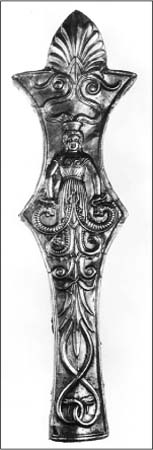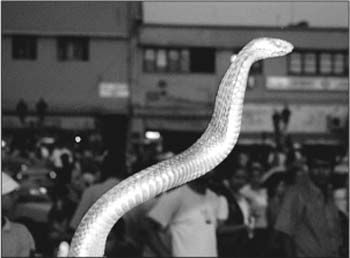The Good and Evil Serpent (12 page)
Read The Good and Evil Serpent Online
Authors: James H. Charlesworth

What could the snake symbolize to the observant human in antiquity? This is a complex question, and we need to be aware of two factors. First, the ancients were more in tune with the environment than we are today. They knew themselves as a part of nature. Most important, unlike most of us, they lived within nature. While we often are far removed from nature by asphalt, concrete, automobiles, and so-called music blaring in our ears, the ancients heard the sounds of animals—birds and donkeys—when they awoke. We see snakes only in zoos; they saw them in gardens and even in houses.
Far too often I hear confused, clearly unreflective comments. Those who say, “I hate snakes” are often afraid of them, but also fascinated by them. Those who claim to detest snakes may stand for a few minutes before giraffes, camels, lions, and elephants; but they are mesmerized for hours at a serpentarium in a zoo. The herpetologist at the Smithsonian, J. A. Peters, estimates that over 3,344,000 specimens of reptiles were imported to the United States in 1968–1969, and probably about one million were snakes.
44
That means people in the United States are fascinated by and attracted to snakes. As J. Coborn states in
The Atlas of Snakes of the World
, the human is naturally curious about most things and wants “to know a little more about those things that frighten him or that he does not fully understand. Because snakes are imagined to come under the categories of evil, dangerous, slimy, devious, and unknown, people like to know more about them.”
45

Figure 12
. Serpent Goddess. Courtesy of the Hermitage. JHC
Before the advent of civilization and the move into villages and then cities, the ancients were hunters and gatherers, moving in and with the flow of other animals. We civilized humans, who for approximately the past five thousand years have lived within cities, have been consecutively losing our physical abilities—especially to hear and see—and have forfeited a close relation with nature that is necessary to appreciate such animals as snakes. The snake shares our earth and belongs to our natural heritage.
46
So, it behooves us to listen to the ancients who could, and did, observe snakes from the beginnings of human existence, perhaps over three million years ago.
47
THE MYSTERY OF THE SNAKE: THIRTY-TWO VIRTUALLY UNIQUE FEATURES
At the outset, we should pause and imagine how we should ground ophidian symbolism in reality. Most promising would be to study the snake and compare it with other creatures.
48
The snake represents about 2,900 species that belong to the class Reptilia, the order Squamata (scaly creatures that include lizards), and the suborder Serpentes or Ophidia; thus, both Latin and Greek have contributed to the name of its suborder. The size of snakes is not certain, but ranges from 11.5 centimeters to nearly 10 meters. The weight of a South American anaconda can exceed 150 kilograms.
49
One hears from eighteenth-and nineteenth-century explorers about how they encountered a snake over 12 meters long. Snakes can grow to enormous lengths, but careful scholars experience the sometimes threatening dimensions of nature without excessive exaggeration. For example, during his expedition in 1799–1800 to South America, Alexander von Humboldt reported seeing in one glance six 6-meter alligators, and being “accompanied by occasional 7-meter-long anacondas swimming alongside.”
50
Thirty-two features tend to make the snake distinct or unique, compared to other creatures the ancients met, such as the lion, bear, tiger, dog, camel, donkey, and cat. As C. Mattison states in
Snake
, “There has always been something of a mystery about snakes. How can they move so quickly without legs? How can they kill prey with only a single bite, delivered at the speed of an eye-blink? And how do they swallow prey whole when it may be several times bigger than their jaws?”
51
First, the snake has neither arms nor legs.
52
Although a fossil snake with legs has been recovered, it is ninety-five million years old.
53
The present creature called a snake is a “limbless tetrapod” (Greek for “four feet”); it remains on the earth when it moves. It does not pound the earth as a horse or a human does. This could signify that the snake is earthy in the sense that it is attuned to and sensitive to Mother Earth, from which we come and to which we shall all return.
The movement of the snake is also unusual.
54
Its locomotion is varied, but it often leaves a “serpentine” trail in the sands of the desert; that is, it moves forward by moving left to right and often moving backward to move forward. There is a quasi-circular rhythm to the movement. This serpentine movement can easily be seen as symbolic of time, as it also goes forward but also frequently is repetitious in its main features; thus, human history is not from war to peace, or from sickness to health, but a repetition of these in some forward hopeful progression. The snake thus becomes a symbol of time, especially in Ouroboros (the presentation of the serpent with tail in its mouth).

Figure 13
. Cobra. Marrakech. JHC
Second, the snake has no ears. It has lost the eardrum (tympanum), outer and middle ears, and also the Eustachian tube. Only the uninformed believe that a cobra can hear the airborne sounds of a snake charmer who plays a musical instrument and sways to the sounds. Yet, very well-informed experts are influenced by such “authoritative” reports as the one by J. A. MacCulloch in the otherwise perspicacious entry in the
Encyclopaedia of Religion and Ethics:
“As certain snakes are susceptible to musical, rhythmical sounds or movements, these are used by snake-charmers to exhibit their power over them.”
55
One who has handled and studied snakes would know better than to be misled by such a claim. The snake can only “respond to low-frequency waves,”
56
so a cobra is simply following the movements of the snake charmer’s flute.
57
The deafness of a snake could signify to the imaginative that it is attuned to otherworldly voices, since it is deaf to earthly noise. It thus can become a symbol for wisdom.
Third, the snake is voiceless. It can hiss, but it cannot bark like a dog, sing like a bird, purr like a cat, or whinny like a horse. Thus, the snake has no vocal way of communicating with humans. That could imply that it lives in the world of silence in which the word of God alone can be heard. Even more profound thoughts could be generated by reflections that communication is impossible where there is no silence, and that silence is the essence of language.
Fourth, whether possessing a round or slit eye, the snake has no eyelids; only a scale, the brille, covers the eyes of most snakes. And some snakes have no vision.
58
That could denote the open-eyed quality of the snake. It can see and is not blinded by blinks and disrupted vision. The eyes of some snakes—notably the Boomslang of South Africa and the nocturnal Yellow Blunt-headed Vine Snake of Costa Rica—are enormous.
59
Again, along with its state of being earless, this creature might appear to some ancients to be a symbol of special wisdom. Noticeably, most images of a snake in antiquity depict the eyes in special ways.
Fifth, the snake has not only a limbless body but is elongated. That could symbolize unity and oneness. It is also symbolic of simplicity, and that can be imagined as attuned to wisdom and purity (as in: purity of heart is to will only one thing).
Sixth, the snake moves rapidly and without making a sound. That attribute could symbolize swiftness and dexterity. It can also connote elusiveness, which is a characteristic of deities imagined or experienced. Its elusiveness, as well as fear of it, may have given rise to the following limerick by Edward Lear:
There was an old man with a flute,
A sarpint ran into his boot;
But he played day and night,
Till the sarpint took flight,
And avoided the man with a flute.
60
Seventh, the male snake has two “penises” (the term is “hemipenes”) that are solely used for copulation, and either may be so utilized.
61
That unique somatic quality could enable the snake to symbolize not only the erotic but also fertility. The female also should be included now; she produces so many offspring that an observer would imagine that the creature was an ideal symbol for fertility.
Eighth, the snake has a split tongue that can exit its mouth through a hole; that is, the snake does not have to open its mouth to send forth its tongue.
62
The bifid tongue, along with the two penises, can symbolize duality. It can also denote duplicity and the ability to say two things at the same time. Thus, the snake can symbolize lying. This symbolic meaning of the snake has misled some commentators on Genesis 3.
Ninth, the snake eats in a vicious manner, and all snakes are carnivores.
63
This “degenerate quadruped”
64
can ingest an animal that outweighs it.
65
The scene can be revolting to humans when one sees a reptile swallow whole a beautiful bird, an impala, pet dog, or other creature.
66
All snakes swallow animals whole, and anacondas along with the aptly named boa constrictor crush the life out of helpless creatures. In zoos, animal specialists will frequently show the public a lion eating supper, but never a king cobra swallowing a live fawn whole.
67
This characteristic of the snake could cause fear, wonder, astonishment, and awe. Folklore associates the pigeon with the serpent, whose bodies are similar, not because they are monsters, but because they are wonders.
68
Frequently, artists use the serpent to create in their viewers the feeling of fear and dread. For example, Kubin Otakar (1883–1969), an Eastern European who was influenced by Impressionism and Neoclassicism (especially works by van Gogh and Gauguin), painted in 1908–1909
Der Schlangenbeschwörer
, which is now in the Saarlandmuseum.
69
The title of the painting means
The Serpent Exorcist
. The dark painting is riveting, depicting an easterner, perhaps an Indian, playing a flute before which four cobras—four times his size and twice his height—not only rise far above him but encircle him. He is also alone and in an abandoned subterranean chamber. He appears peacefully playing away on his musical instrument, and perhaps with eyes closed. He seems unperturbed, and even unaware, of the monsters swaying above him. The painting is impressionistic, but it inspires subjective reflections regarding fear and anguish. One is struck with questions about deadly power. The cobras do not threaten, but their sheer massiveness and immediate presence awaken primordial fears. Such reflections raise other questions. For example, why do the depictions of extraterrestrials look like snakes with large eyes?
70
Tenth, massive snakes can sometimes go for months without eating. This phenomenon could denote that this creature is different from others: it does not experience the need to eat as do other animals. Observing a snake that has no need to forage for food could suggest that it might be divine or at least godlike. It is easy to imagine the ancients pondering this question: Is not this creature, so unique and awesome or “awe-full,” blessed by the gods or fed by the gods?